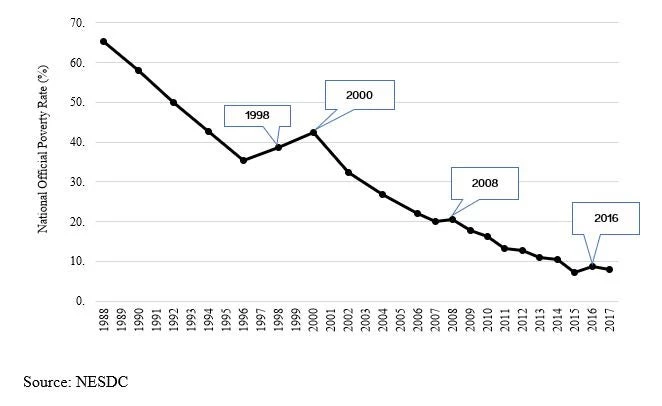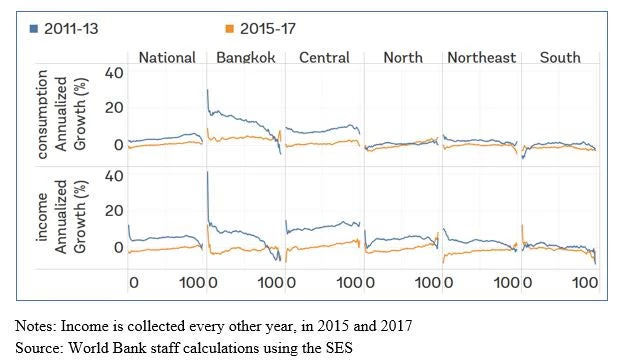 ความยากจนและความเสมอภาคยังคงเป็นหัวข้อที่เกี่ยวข้องสำหรับประเทศที่มีรายได้ปานกลางอย่างประเทศไทย
ความยากจนและความเสมอภาคยังคงเป็นหัวข้อที่เกี่ยวข้องสำหรับประเทศที่มีรายได้ปานกลางอย่างประเทศไทย
Like many other countries in the East Asia Pacific, Thailand has been enormously successful in reducing poverty over the last few decades. In 2017, the extreme poverty rate in Thailand was only 0.03% and the number of extreme poor now measures in the thousands. Compared to other countries, this sounds pretty good.
The reality is, recent droughts and economic downturns have pointed to vulnerabilities in Thailand, as poverty increased in 2016 during a particularly poor agricultural year. With a rapidly aging population, a conflict-affected Southern region, and one-third of the labor force still employed in low-productivity agriculture, poverty and equity remain relevant topics for this upper-middle-income country.
Based on recent analysis done by the World Bank Thailand Poverty and Equity team, we’ve picked out seven statistics in time for End Poverty Day 2019 that clearly demonstrate why Thailand still needs to focus on reducing poverty and improving equity.
1. The International Poverty Line threshold of $1.90/day converts to about 26 baht/person per day
In 2017, the extreme poverty rate in Thailand based on the International Poverty Line was 0.03%. If one converts the International Poverty Line to local Thai baht, the value is very low at about 26 baht/person per day, which is inconceivable for many Thais to be sufficient for an acceptable life. Monitoring poverty at higher poverty lines is increasingly important as countries grow richer. A poverty line that is too low can lead to an inaccurate assessment of an individual’s ability to function in society in a socially acceptable manner. If we use the upper-middle-income poverty line of $5.50/day or 75.7 baht, the poverty rate increases to almost 8%, which is more in line with Thailand’s national estimate.
2. Thailand’s national poverty rate increased in 2016, the fourth time since 1988.
Since the late 1980s, when the Office of the National Economic and Social Development Council (NESDC) began publishing national poverty rates, official poverty rates measured by the government of Thailand increased in only four instances. Three of these instances coincided with financial crises (1998, 2000, and 2008). The fourth and most recent increase in poverty occurred in 2016. The increase in poverty from 2015 to 2016 was small, about 1.5 percentage points based on national estimates by the government of Thailand, as well as the global upper-middle income poverty line. While nationally, the increase is small, there are larger changes by regions (see #3 and #4 below).

3. The growth of the bottom 40% was negative from 2015-2017 and uneven across regions
Related to an increase in poverty, the bottom 40% of the population saw their average household consumption and incomes decline from 2015-2017.
Growth across regions is uneven. Bangkok and Central areas typically enjoy the highest growth, and the difference among other regions can be quite large. From 2011-2013, annual growth at the mean was about 3.8%. During this same period, Bangkok averaged annual growth rates well above 10% per year, while the North, Northeast and South regions experienced growth below 5%.
Between 2015-2017, Thailand saw a much slower growth period. While household consumption growth was still present, income growth was almost erased. The fall in agricultural prices and negative impacts on farmers was expected, though broad declines in household income was seen in other regions as well.

4. While the increase in national poverty was small, increases were higher in some regions
By official measures, poverty is the highest in the Southern region. Between 2015-2017, poverty also increased the most in this region in percentage point terms. The official poverty rate was 9.9% in 2015 and 11.8% in 2017 in the Southern region, an increase of almost 2 percentage points.

5. The two poorest provinces in Thailand are in conflict-affected areas in the Southern region.
While poor households are likely to be in agriculture, the profile of the poor is not one-dimensional. Tackling poverty in Thailand will also mean focusing on ethnic minorities, lagging regions in mountainous and border areas, conflict, and fragility. The two poorest provinces are Pattani and Narathiwat, neighboring provinces in the conflict-affected Southern region with poverty rates of 34.2% and 34.17% respectively.

6. The pace of poverty reduction has been the fastest in Bangkok
By region, Bangkok has enjoyed the fastest pace of poverty reduction. Since 1988, the annualized change in poverty reduction in Bangkok has been about 10% per year; its official poverty rate dropped from 24.7% in 1988 to 1.1% in 2017. The Central region had the second fastest pace of poverty reduction. Higher levels of development and rates of growth are typically seen in Bangkok and Central regions where most of the country’s high-valued production in manufacturing and services is located.
The North, Northeast, and South regions experienced the slowest pace of poverty reduction. These regions are poorer, fragile, less diversified, and more reliant on agriculture. Agricultural regions are also sensitive to changes in commodity prices and natural disasters including droughts and floods.

7. Perceptions about living standards in Thailand worsened, coinciding with the recent increase in poverty
Starting in 2016, there was a downturn in perceptions among those surveyed in a Gallup World Poll. Perceptions worsened in some questions related to their life, financial well-being, standards of living, and income. For example, starting in 2016, many more respondents began indicating that they did not have enough money for food or shelter at least once in the last year.

These seven statistics demonstrate that there are still poverty and equity related challenges in Thailand. Even though Thailand is now an upper-middle income country that has nearly eradicated extreme poverty, data show that poverty reduction has slowed down and have been uneven across the country. Stay tuned as the full report on Poverty in Thailand will be published in 2020!


Join the Conversation